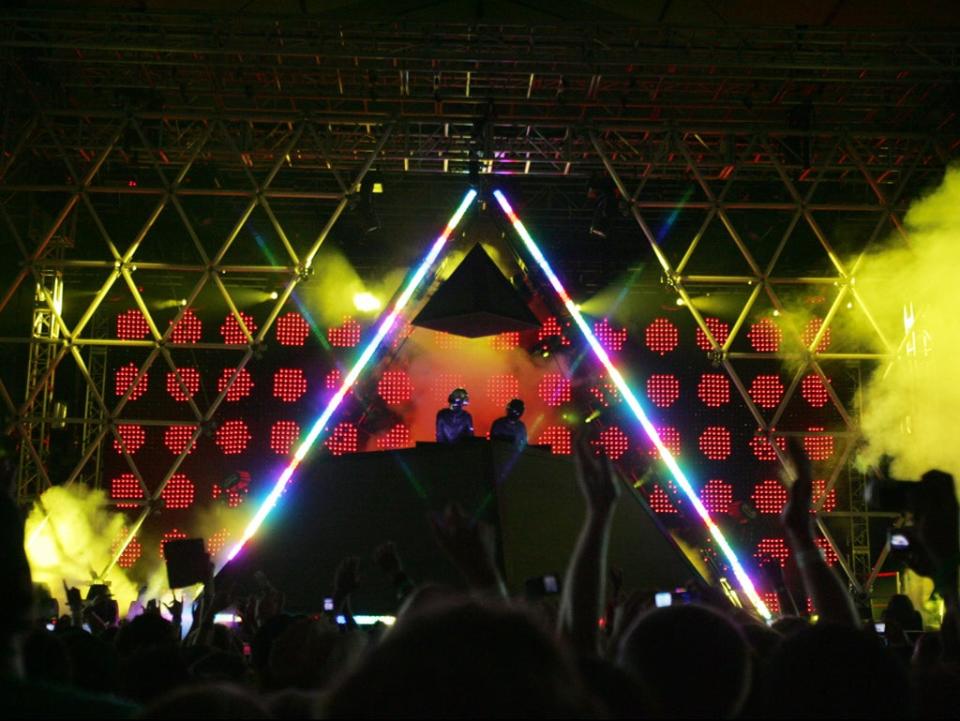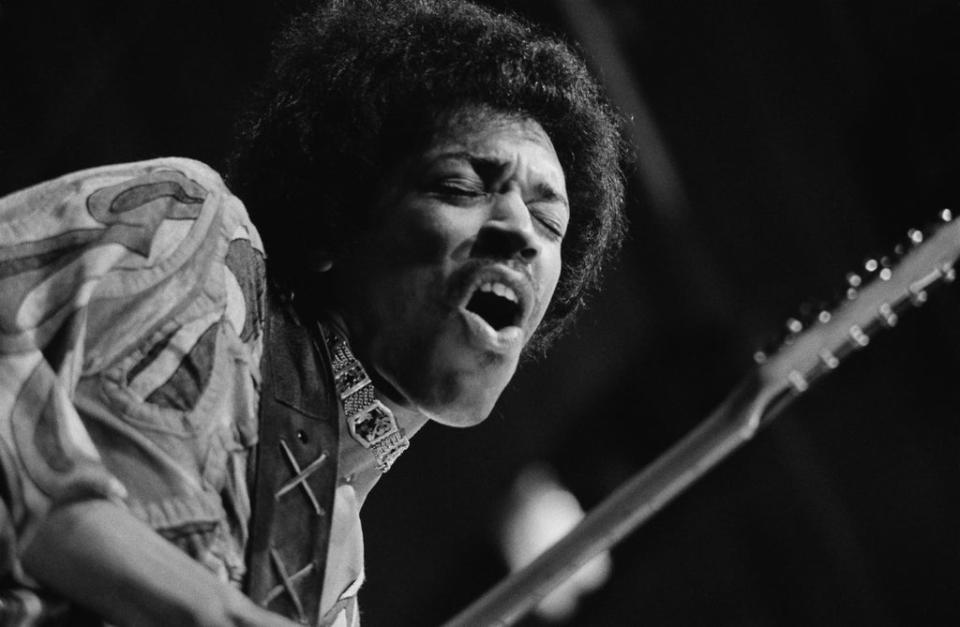The 12 most infamous gigs of all time, from Oasis at Knebworth to the Rolling Stones at Altamont

After the horror show that was 2020, last year was another tough one for fans of live music.
Sure, there was a handful of notably great concerts that did manage to dodge and weave between all the various pandemic restrictions, including momentous sets here in Los Angeles from the likes of The Rolling Stones and BTS. But we’re still some distance from being able to attend gigs in anything like normal conditions.
During this lull in our regularly scheduled programming, it’s no surprise that our thoughts have been turning back in time, as we seek to remind ourselves of the good, the bad and the downright messiest nights in music history.
Featuring appearances from Tina Turner, Elvis Presley and The Sex Pistols, here are the 12 most infamous gigs of all time:
12. Oasis at Knebworth (1996)
There were many remarkable things about the two history-making nights Oasis spent in the grounds of Knebworth House in August 1996. Most famous is the scale of the crowd that turned up to see them: 250,000 fans and famous faces, including a decent portion of that year’s England squad. Equally mind-blowing is the speed at which the Mancunians achieved these dizzy heights. When they walked onstage for the biggest rock’n’roll shows in British history, it was just three years, two months and 10 days after manager Alan McGee spotted them playing to an empty King Tut’s in Glasgow, and signed them on the spot.
11. The Doors at New Haven (1967)
Trouble began before The Doors had even taken to the stage in Connecticut on 9 December 1967. The story goes that frontman Jim Morrison was “making out” with a fan backstage when he was asked to move on by a slow-witted police officer, ostensibly hired to protect the band. “Eat it!” Morrison replied. The cop told him: “Last chance…” to which the singer wittily retorted: “Last chance to eat it!”. The cop maced him, much to the organisers’ chagrin. The show was delayed to allow Morrison to recover, but when he got on stage he took the opportunity to recount the whole experience and to dismiss his attacker as a “little blue pig”. That was all the excuse the police needed to shut the show down, and Morrison was carted off and later charged with inciting a riot, indecency and public obscenity.
10. Tina Turner at Estadio do Maracana (1988)
Tina Turner made her name in the Sixties as the lead singer of the Ike & Tina Turner Revue with a string of incendiary performances that earned her the regal sobriquet, “The Queen of Rock ‘n’ Roll.” By 1988, there were rumours that Turner might bring her live career to a close after her “Break Every Rule” world tour, but they proved unfounded as she went on to smash box office records around the globe. Most notably, her show at Estadio do Maracana in Rio de Janeiro on 16 January 1988 pulled in a sold-out crowd of 180,000, setting a new record for the highest attendance at a performance by a solo artist.
9. Daft Punk at Coachella (2006)

On the night of Saturday 29 April 2006, there was only one place on the planet discerning music fans wanted to be: the Sahara Tent at Coachella Festival. The problem? The tent was only built for 10,000 and, according to legend, there were four times that many people trying to squeeze inside to watch Daft Punk’s triumphant debut of their pyramid-shaped, spaceship-inspired new live show. Their set (and the subsequent Alive! Tour) permanently transformed the way electronic music would be performed live, but none of the many imitators who followed could ever quite match the illustrious standard set by the now-retired robots.
8. Nirvana at Reading Festival (1992)
In the run-up to Nirvana’s headline slot on the Sunday night of 1992’s Reading Festival, rumours swirled that the band might not make it due to tension within the band and frontman Kurt Cobain’s heroin addiction. Sure enough, when the moment arrived things seemed tense. Cobain – wearing a wig and a hospital gown – was pushed onstage in a wheelchair by Melody Maker writer Everett True. Cobain struggled to his feet, sang a line from Amanda McBroom’s “The Rose” and promptly collapsed. It was all a ruse: after briefly lying motionless on the stage, Cobain leapt to his feet and the band roared through a blistering set which included almost all of 1991’s Nevermind.
7. The Band’s Last Waltz in San Francisco (1976)
On Thanksgiving 1976, The Band called time on their touring career with a farewell performance at San Francisco’s Winterland Ballroom – and they went out with a bang. They were joined for the one-night-only spectacular by their former employers Ronnie Hawkins and Bob Dylan, as well as a host of stars including Neil Young, Joni Mitchell, Dr John, Van Morrison and Ringo Starr. The whole thing was immortalised by Martin Scorsese, in what remains the quintessential concert film, The Last Waltz.

6. The Patti Smith Group at CBGB (1975)
During a seven-week residency from March to April 1975, The Patti Smith Group transformed from a poetic art project into one of the most important and influential bands in punk, putting Lower Manhattan club CBGB firmly on the map in the process. Smith’s debut album Horses was forged during these intimate performances, which saw the band alternating opening and closing slots with fellow innovators Television. “I remember one night standing outside CBGB, in the doorway of the derelict hotel next door, smoking a joint,” recalled Patti Smith guitarist Lenny Kaye later, “and realising that this was the kind of gathering of psychic energies I’d always dreamed of when, say, I would read about the San Francisco scene in 1966.”
5. Elvis: The Comeback Special (1968)
By 3 December 1968, Elvis Presley hadn’t performed live in seven years, with his last public performance taking place on 25 March 1961 in Hawaii. In the interim, the Sixties had happened, and the musical world had transformed while Presley was off making movies. His return to the stage for a televised special was a make or break moment for the King, and its eventual success re-launched his singing career. Nobody would ever look at a a black leather suit in quite the same way again.
4. Johnny Cash at Folsom Prison (1968)
In 1953, while serving with the US Air Force, Johnny Cash saw the 1951 film noir Inside The Walls of Folsom Prison. The movie inspired Cash to write a song imagining what it would be like to be incarcerated in the California prison, and it became his second ever single in 1953: “Folsom Prison Blues.” The song became popular with inmates, and on 13 January 1968, Cash played two sets inside the walls of the prison itself. The performance quickly became one for the history books, at once celebrating the outlaw life and offering a stinging critique of the prison experience.
3. Jimi Hendrix at Woodstock (1969)

Jimi Hendrix turned up late for Woodstock. The initial plan had been for him to open the festival with a secret acoustic set on the Friday afternoon, but he didn’t make it to Max Yasgur’s farm in Bethel, New York until noon on Sunday. Then it was decided he would close the festival, which by that point was already suffering from so many delays that it wouldn’t be done until Monday morning. Hendrix eventually took the stage at 8:30am, playing a two hour set that is best remembered for his incendiary transformation of “The Star Spangled Banner” into a blistering anti-war anthem.
2. The Sex Pistols at Manchester Lesser Free Trade Hall (1976)
On 4 June 1976, less than 40 people saw The Sex Pistols play Manchester’s Lesser Free Trade Hall. It’s been called the day the punk era began, as – according to legend – almost everyone in the venue that night went on to start a band. The Buzzcocks formed the next day, while also in attendance were Ian Curtis, Bernard Sumner and Peter Hook, who would go on to form Joy Division, The Fall’s Mark E Smith, and one Steven Patrick Morrissey. By the time The Pistols returned to Manchester a few weeks later, The Buzzcocks were their support band and punk had very much arrived.
1. The Rolling Stones at Altamont (1969)
The hippie dream of the Sixties died on 6 December 1969. Just four months after Woodstock, California’s answer to the dreamy New York-state festival was the Altamont Free Concert, featuring appearances from Santana and Jefferson Airplane along with a headline set from The Rolling Stones. However, hiring motorcycle outlaws the Hell’s Angels to run security proved to be an unwise choice. The concert descended into violence, and 18-year-old fan Meredith Hunter was stabbed to death during The Stones’ performance. In Esquire, critic Ralph J. Gleason wrote: “If the name 'Woodstock' has come to denote the flowering of one phase of the youth culture, 'Altamont' has come to mean the end of it.”

 Yahoo News
Yahoo News 